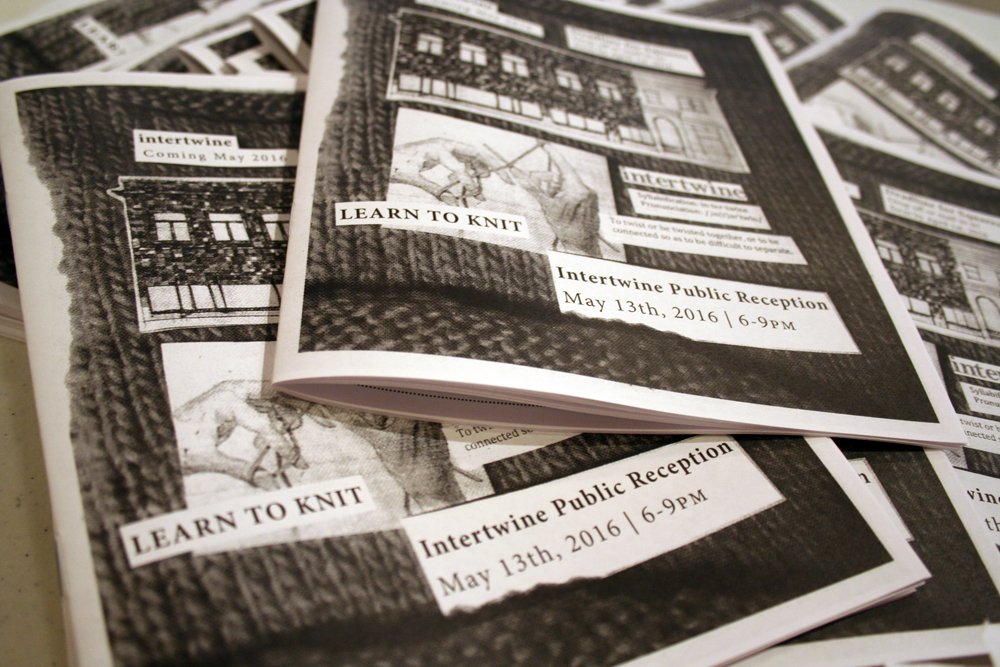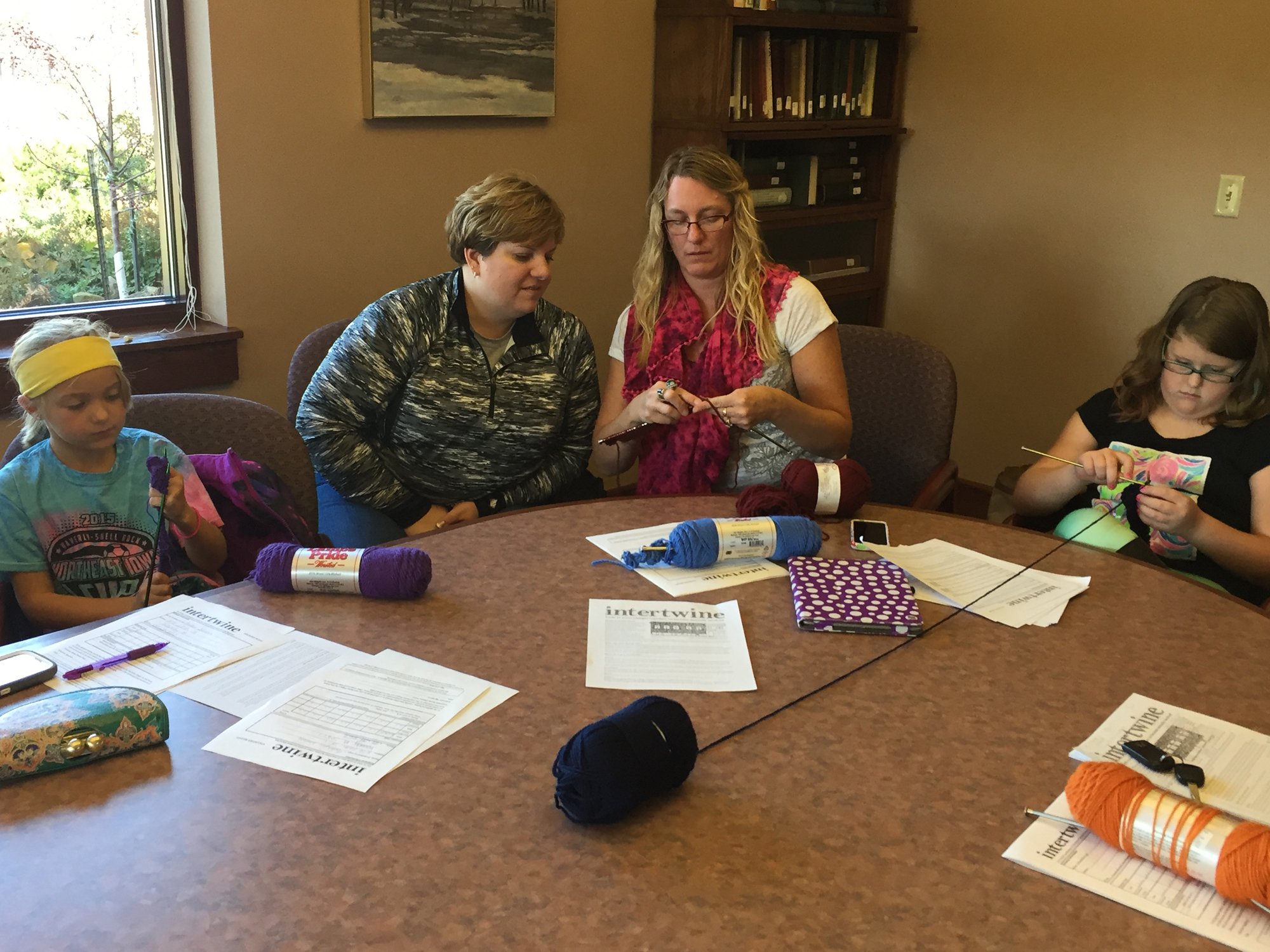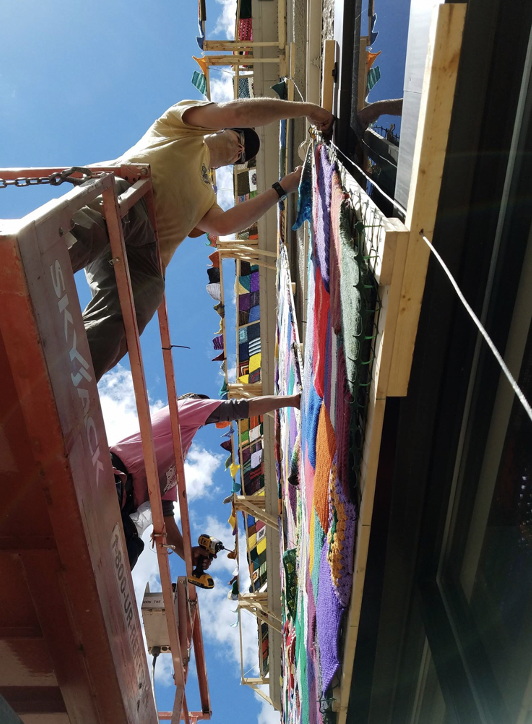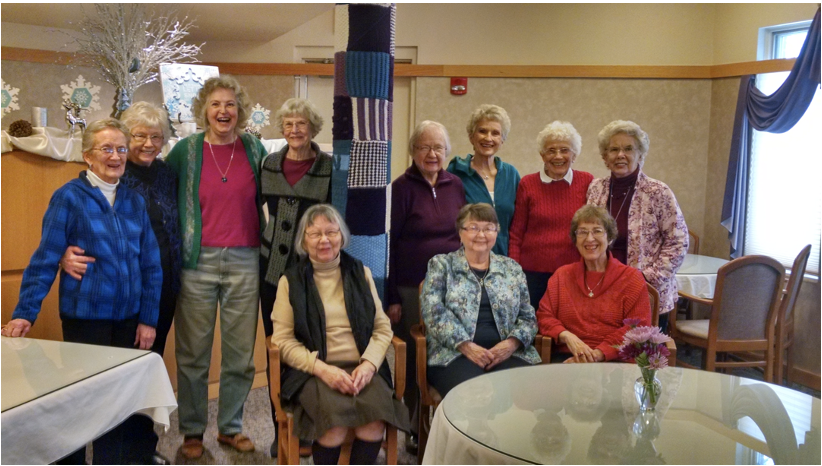Intertwining a Community
I don’t know how to knit.
I know how to paint. I’m incredibly comfortable standing in front of an easel, 90’s hip-hop blaring, with a paintbrush in my hand. I am not comfortable with a ball of brightly colored yarn and two knitting needles.
That is significant for two reasons. First, as a community art specialists and an academic, I’m supposed to know how to do things. Second, and more surprisingly, in 2016, I organized Intertwine, a project involving 125 makers from across the country to yarn bomb ISU Design on Main, a storefront in downtown Ames that was a former satellite studio facility for Iowa State University’s College of Design and included a community gallery space.
Many of you may not know what a yarn bomb is. Imagine wrapping a public structure or place in a giant handmade sweater. (See below.)
Intertwine installation, Ames, Iowa. 2016.
In other words, I didn’t know how to knit, so I got my feet wet by knitting this building. So how did this happen? How did a painter end up wrapping a historic two-story building in a material I don’t know how to use with 125 people from age 9 to 93?
I embraced the expertise of my community.
In 2015, as both the de facto gallery manager for Design on Main’s community gallery and the community arts specialist for ISU extension, I thought it would be way cool to create a community-wide art project that could bridge campus with community, and provide an opportunity for folks who don’t self-identify as artists to feel the joy and comradery that comes with artistic collaboration.
But I ran into a wall when considering what medium to use for this project. If I had a nickel every time someone has told me that they love art but they can’t even draw a stick figure, well, I wouldn’t be talking to you today. I’d be lounging on a beach in Bora Bora, boozy drink in hand. So mural painting, my area of expertise, seemed dicey. Too intimidating.
I wanted folks to be able to participate from anywhere, so it would need to be lightweight to mail, and something that required little to no equipment. And I really wanted the project to be reused in a meaningful way, not just get dumped in a landfill.
Yarn seemed perfect! Accessible, inexpensive, and durable. The elephant in the room was, like I said before, my utter ignorance of knitting. How’d I get past that?
Kristin M Roach, artist extraordinaire. Photo courtesy of Kristin M Roach.
Let me introduce you to Kristin.
A petite, raven-haired Ames-artist, author, and small business owner, Kristen was my hired fiber consultant. With her ever-present cup of tea in hand, she helped me determine how much yarn we would need to cover the buildings, a legitimate truckload, which we bought locally, and procured through donations. Kristen also wrote a free 30-page zine, or a self-published magazine, for Intertwine participants that provided step-by-step knitting instructions. She taught a free public knitting class and a free crocheting class at DOM. She also assisted with the public knitting circles we had at the gallery twice a month during the year.
Kristin M Roach, Intertwine Zine, 2015.
In order to get enough squares to cover the building, I wanted to open up the project to participation outside of Ames. How’d we engage with non-local communities?
Angie Steuer (center left) teaching a free knitting class at the Waverly Public Library. Photo courtesy of Angie Steuer.
With the help of people like Angie.
Angie’s an arts teacher in Waverly, Iowa, that I had met through Extension. I’m literally not sure I’ve ever seen Angie not smiling – at her kids, her students, her community. She loved the Intertwine idea and volunteered to use it as a service-learning project for all her students at St Patrick’s Lutheran School. She also taught a free knitting workshop at the Waverly Public Library.
I also made it as easy as possible to participate – send in a one foot by one foot knit or crocheted square, any color or any pattern, by April 1, 2016. I’d even ship supplies. By that spring, boxes and boxes of knit squares in every color and pattern, some with images and words, from communities like Waverly across the US, began to overwhelm my measly faculty mailbox and take over our mailroom. (Sorry, colleagues.)
I need to make another full disclosure.
Like I mentioned before – I am a painter. I am not a three-dimensional artist, like at all. In fact, I had no real plan on how to attach the yarn bomb to Design on Main until after I received funding from two grants. My thought was to just hang it from the roof and kind of throw it over the side of the building. Seemed easy enough. If you are an engineer, you may find it miraculous that with that logic and lack of planning, I was ever able to pull this off. Want to know how?
Aaron.
Let me introduce you to Aaron.
Aaron has the left brain to my right, with a background in engineering and drafting. Aaron designed an intricate structural system to support all these squares. Did I mention that ISU Design on Main is a historic building? That meant that we couldn’t put any hardware into the façade of the building to attach the yarn bomb. Aaron devised an impressive cable system that ran from the roof to the sidewalk, ensuring the yarn bomb would be safe and secure for the 3-week installation.
For the week of installation, Aaron was the most popular and most recognizable person on Main Street – a Carhartt-wearing, safety helmet-sporting man with a loaded toolbelt standing atop a scissor lift, giving orders to community members on the best way to wrap a building in a sweater. At the time, Aaron was my boyfriend. He’s now my husband, so this project didn’t freak him out too much.
Aaron and Chris Martin installing Intertwine, 2016. Photo courtesy of Mike Miller.
Finally, I mentioned an important component to Intertwine was its afterlife. I partnered with the Youth and Shelter Services office here in Ames to find a home for the yarn bomb after we deinstalled it. YSS has the Achieving Maximum Potential Program that sets up foster youth who are moving into their first independent housing with a suitcase full of household supplies. In 2017, we supplied YSS with 45 7’ x 4’ multicolored handmade blankets. But the ripple effects of Intertwine didn’t stop there.
A bunch of us creating blankets for Intertwine at Alluvial Brewery in Ames, 2016. Carol Horn is third from left.
Meet Carol.
Retired and living in Story City, Carol quickly became one of the MVPs of Intertwine. She single-handedly knitted over 200 1’ x 1’ panels over the year for the project. An introvert and not one to brag or call attention to herself, Carol is a person whose eyes light up when she talks about her creative projects. She doesn’t go a day without making something, and typically for someone else. After Intertwine, Carol began partnering with Story City organizations, such as the local library, and created her own knit treasures that she’s left on storefronts and in trees.
Carol’s work was featured in The Ames Tribune in 2019. Photo courtesy of The Ames Tribune.
And meet the Crafty Cresters, this group of women from Northcrest Retirement Community in Ames formed a biweekly craft circle in 2015 to participate in Intertwine. Five years later, they are still meeting and creating joyful projects for their residents, like a dining room yarn bomb, blankets for their memory ward residents, and holiday themed door muffs each year.
The Crafty Cresters, Northcrest Retirement Community, Ames, Iowa. These ladies yarn bombed their dining hall (see middle pole) after participating in Intertwine.
Miraculously, I still don’t know how to knit. I do however think that this fact was probably insurance for Intertwine’s success. My lack of experience and expertise made room for others in the community to fill these roles, which provided formal and informal leadership opportunities for people who maybe wouldn’t have gotten their feet wet in other situations, built new and strengthened existing relationships, and created an infinitely stronger and more creative project.









